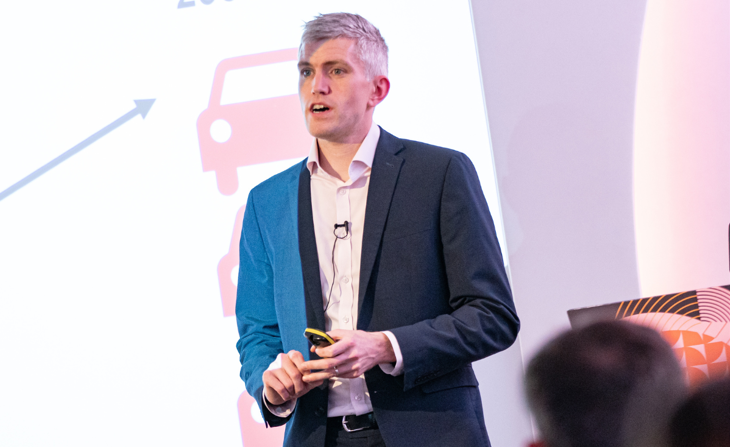
Generative Artificial Intelligence (AI) may be flashy, but investors cannot forget the other, more “boring” robots that currently buoy global markets.
So said James Pomeroy, Global Economist at HSBC, in a discussion around the macroeconomic outlook for the world economy in 2024.
Pomeroy was speaking at Insurance Investor Live | Europe, in London last week. His talk focused primarily on the way markets are set to change as populations change – due to factors such as declining birthrates, ageing populations, and longer lifespans across the globe – and what these macro shifts will mean for institutional investor portfolios.
“We’re [now] seeing the fastest growth rate in pensioners around the world,” said Pomeroy. This means, of course, that pension funds will need to invest for a greater number of individuals over a longer period – shifting allocation strategies significantly.
“We’re [now] seeing the fastest growth rate
in pensioners around the world.”
“There are big questions over how big the world population could become,” Pomeroy continued. For example, China was overtaken by India this year as the world’s most populous country, whilst China’s population fell by 800,000.
This drastic shift has seen the nation grapple with larger, existential questions about it’s future needs. It has also put a massive strain on the country’s workforce and economy, which will likely worsen in decades to come.
The single most important driver of the future economy, however, Pomeroy said, was the fact that birth rates were in terminal decline. “One factor is that people can’t afford or don’t want children,” continued Pomeroy. “South Korea is a striking example. Their [birth rate] is set to drop by more than half, 60%, in the next century.”
Changes to birth rates, and therefore population sizes, could significantly impact investors’ portfolio makeup – especially for insurers and pension funds that need to prepare for this shift in their liabilities and the needs of their ageing client base. “There will be a need to reconfigure allocation because of demographics,” Pomeroy said.
“There will be a need to reconfigure allocation
because of demographics.”
He noted that older workers, in many economies, were considered more ‘productive’ – which meant they earned and spent more the older they got.
For many, spending habits change over time, too, trending toward increased ‘discretionary spending’, or spending on non-critical but pleasure-enhancing experiences. “We will have billions more people with discretionary spending power,” he added. “There will be sustained growth in discretionary spending.”
In January, Xavier Debrun – Head of Economics and Research, National Bank of Belgium, and a member of the European Fiscal Board – identified four key macroeconomic megatrends as 1) ageing population, 2) climate change, 3) trade fragmentation, and 4) income inequality.
These, he said, emerged as global issues partly because of the unsustainability of public debt, and could potentially lead to its extinction. “These trends mean governments need an overall higher primary surplus,” he continued, citing difficulties that low-to-medium wage earners have experienced trying to save in current circumstances, with a high cost of living.
A wider impact could be enhanced reliance on government pensions, which would have reverberating effects on the global economy – and the ways pension pots are invested.
Pomeroy also pointed to digitalisation and automation as investment trends of the future, especially post pandemic. “Because of Covid-19, we’re going into a wave of automation,” he said. “But it’s important to remember that boring robots really matter.”
“You cannot forget all the boring robots that
people are already used to.”
The category of so-called ‘boring’ robots, explained Pomeroy, encompassed all of the seemingly small technological advances that make life, as people today know it today, what it is. They included everything from computers and smartphones to automobiles and cash machines – which, for many, have made additional technological advancement possible and, in some countries, have helped alleviate poverty.
“You cannot forget all the boring robots that people are already used to,” added Pomeroy.
This sentiment is not unusual. Recently, Rachel Norris – Senior Vice President and Construction Leader in Real Estate at Lockton – told Insurance Investor that ongoing updates to technology around energy-efficient buildings were pushing investors to reconsider real estate.
There were, she added, “patterns we haven’t previously seen” around building integrity, maintenance, and risk engineering that made the asset class increasingly viable for net-zero-oriented portfolios. These developments weren’t particularly flashy but were sound investment opportunities for those with long-term mindsets.
When it came to one of the day’s hottest topics – AI – which garnered new interest from the audience, Pomeroy’s view was that it was ultimately beneficial, an additive, rather than something to fear.
“AI is a hand holder, not a job killer.”
“AI is a hand holder, not a job killer,” he said. “I think the economy is genuinely better off with office workers watching two hours of Netflix than spending those two hours sitting at their desks not working.”
The potential of tools like ChatGPT was, for Pomeroy, that they could eliminate ‘busy’ work – or tedious, repetitive tasks – and offer people more leisure time. The result would be an increase in discretionary spending, greasing the wheels of the global economy.
For investors – especially those averse to risk, such as insurers – generative AI was a new, rapidly developing space that left much still to be desired. The mundane robots of daily life could not be overlooked amidst the hype.
These now-ordinary advancements should remain key areas for investor growth and could even present new opportunities for return, said Pomeroy. He urged diligent attention to infrastructure investments, as well – or the technology behind the scenes that will enable, for example, the renewable energy transition in Europe and elsewhere.
Despite the cyclic nature of markets, however, new phenomena do occur, and technology does change. “Do not underestimate change,” said Pomeroy.
As global populations age and new tools become embedded in daily life, investors should stick to the basics whilst also acknowledging that portfolio allocation will have to change, too.